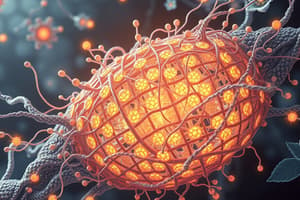Podcast
Questions and Answers
What does diffusion cause?
What does diffusion cause?
- Net movement of solute particles from lower to higher concentration
- Net movement of water only
- No movement of solute particles
- Net movement of solute particles from higher to lower concentration (correct)
Diffusion requires energy for particles to move.
Diffusion requires energy for particles to move.
False (B)
What happens at equilibrium in diffusion?
What happens at equilibrium in diffusion?
Particles move equally in both directions.
What type of diffusion uses special channels for assistance?
What type of diffusion uses special channels for assistance?
Facilitated diffusion requires additional energy from the cell.
Facilitated diffusion requires additional energy from the cell.
What molecules cannot cross the cell membrane in this context?
What molecules cannot cross the cell membrane in this context?
In a hypertonic solution, there is a lower concentration of sugar molecules compared to a hypotonic solution.
In a hypertonic solution, there is a lower concentration of sugar molecules compared to a hypotonic solution.
What happens to water movement until equilibrium is reached?
What happens to water movement until equilibrium is reached?
Water level rises on the side with the more concentrated ______.
Water level rises on the side with the more concentrated ______.
Match the following solutions with their descriptions:
Match the following solutions with their descriptions:
Study Notes
Diffusion
- Movement of molecules from an area of high concentration to an area of low concentration.
- Driven by the concentration gradient (difference in concentration).
- Does not require energy input from the cell.
- Continues until equilibrium is reached, meaning the concentration is equal on both sides of the membrane.
Facilitated Diffusion
- A type of passive transport that uses membrane proteins to help molecules cross the cell membrane.
- Still driven by the concentration gradient.
- Does not require the cell to expend energy.
- Examples include the movement of glucose and amino acids across the cell membrane using specific transport proteins.
Diagram Highlights
- Cell Membrane: The barrier that separates the inside of the cell from the outside environment.
- Aquaporin: A type of protein channel that facilitates the movement of water across the cell membrane.
- Water: A molecule that can move through aquaporin channels due to the concentration gradient.
Passive Transport: Osmosis
- Aquaporins are proteins in the cell membrane that allow water to move across the membrane.
- Sugars cannot cross the cell membrane without the correct protein transport channels.
- Water moves across the cell membrane by osmosis.
Osmosis: Hypotonic vs Hypertonic Solutions
- A hypotonic solution has a lower concentration of solutes (like sugars) compared to a hypertonic solution.
- Water naturally moves from a hypotonic solution to a hypertonic solution.
- This movement continues until the concentration of the solute is equal on both sides of the membrane - this is called isotonic equilibrium.
Diagram Explanation
- In the diagram, the water level rises on the side with the more concentrated solution (hypertonic) because water is moving from the side with less solute concentration (hypotonic) to the side with more.
- This movement of water will continue until the two solutions are isotonic, with the same concentration of water and sugar on both sides of the membrane.
Studying That Suits You
Use AI to generate personalized quizzes and flashcards to suit your learning preferences.
Description
This quiz covers the concepts of diffusion and facilitated diffusion in cellular biology. It explores how molecules move across cell membranes and the role of membrane proteins in such processes. Test your understanding of these essential biological mechanisms.




